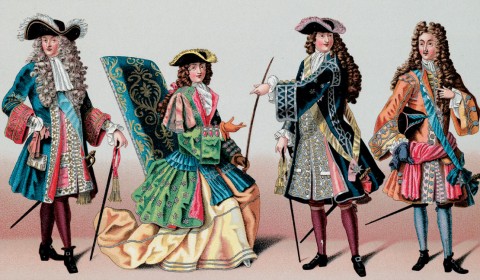Antoine Coëffier de Ruzé d’Effiat, Marquis d’Effiat
Antoine Coëffier de Ruzé d’Effiat comes from family with a prominent status at court. One of his ancestors, Martin Ruzé de Beaulieu, served as Secretary of State of the Maison du Roi, or King’s Secretary, under three Kings of France. Henry III, the last Valois King, Henry IV, the first Bourbon King, and his son Louis XIII.

As he died in 1613, Martin Ruzé de Beaulieu made his nephew, Antoine Coëffier, Marquis d’Effiat, his heir under the condition that this Antoine would take the name of Ruzé as his own. He did so, thus creating the Coëffier de Ruzé d’Effiat branch. This Antoine made it to Maréchal de France and was Superintendent of Finances to Louis XIII from 1626 to 1632. Cardinal Richelieu put big trust into this Antoine, but later came to loathe his son. The infamous Henri Coiffier de Ruzé d’Effiat, Marquis de Cinq-Mars.
Cinq-Mars was introduced at court pretty early in his life, his father being friends with Richelieu, and was also introduced by him to Louis XIII. Richelieu hoped that Cinq-Mars would be become a favourite to the King, which indeed happened shortly after. Richelieu also hoped that Cinq-Mars might use his newly gained favour in favour of the Cardinal, but the opposite was the case. Cinq-Mars tried to convince Louis XIII to actually have the Cardinal executed. This, obviously, didn’t go well with the Cardinal. The Marquis de Cinq-Mars then involved himself into the rebellion of Louis de Bourbon, Comte de Soissons, who plotted, together with Gaston d’Orléans, brother of Louis XIII, to have Richelieu killed. It didn’t go well either. Shortly after, Gaston d’Orléans and Cinq-Mars teamed up again, this time to gain support from the King of Spain for their plans. Richelieu’s spies caught Cinq-Mars in the act. He was arrested and beheaded for treason on September 12, 1642, on the Place des Terreaux in Lyon.
Antoine’s father, Martin Coëffier de Ruzé d’Effiat, was the brother of the Marquis de Cinq-Mars. Born in 1612, he married Isabelle d’Escoubleau, a daughter of the Marquis de Sourdis, with whom he had three children. Antoine Coëffier de Ruzé d’Effiat, Marie Coëffier de Ruzé d’Effiat and Adrien Coëffier de Ruzé d’Effiat. Antoine, born in 1639, was the oldest of the three. Martin held the positions of Gouverneur du Bourbonnais and King’s Lieutenant of the lower Auvergne.
In 1644, upon the death of his father, Antoine inherited the title of Marquis d’Effiat. His mother seems to have passed away the same year.
Some-when between the late 1650’s and the mid 1660’s, Antoine attached himself to the household of Philippe de France. What his motives were is difficult to tell. He could have been either after prestige, money, influence… or affection. Fact is, as Antoine gained the attention of Monsieur, he did not commit the same mistake as many others, to challenge the position of the Chevalier de Lorraine as Monsieur’s favourite. Those who had tried this, all failed miserably. Antoine and the Chevalier seem to have entered some sort of arrangement, in which Antoine helped the Chevalier to keep his position of universal influence and in turn received valuable positions in Monsieur’s household. Such as Premier écuyer to Monsieur, a position the Chevalier’s brother held for the King. As such, Antoine was responsible for everything concerning Monsieur’s stables, from the people who kept them running, to the carriages and arrangements for travels. Monsieur, as it was common, always travelled with most of his furniture and half of his household.
In 1667, Antoine involved himself in the infamous l’affaire des sonnets around Philippe-Jules Mancini, Duc de Nevers. It was an exchange of poetry between enemies and friends of Racine about his play Phaedrus, in which Antoine sided with Racine.
What put Antoine into the history books, was the death of Monsieur’s first wife, Henrietta of England. According to the rumours of the time, Antoine was the person that poisoned Madame’s cup. The most common variant of the story is that the Chevalier de Lorraine, after he had spent time in prison and was then exiled to Italy, sent a strong Italian poison to France, via a Monsieur Morel, which was then used by the Marquis d’Effiat to poison Madame’s cup and thus Madame. The Chevalier is said to have been so upset about Madame actually managing to get him not just exiled, but also thrown into the worst prison of France, that he plotted revenge by poisoning her. As the Chevalier was sent away, and the influence others had on Monsieur grew, and the three of them feared that sooner or later their own influence over Monsieur would be gone and they might lose everything. Thus the Marquis d’Effiat is said to have entered willingly into the scheme to poison Madame and return the Chevalier to court. (I can’t really figure out right now, whether Antoine was in any way reprimanded for his rumoured involvement, as in being temporary sent away, or not. We can presume that he was at least questioned several times.)

Monsieur’s second wife, Liselotte, was all her life pretty sure the rumours were not just rumours. In her letters, she writes several times about the whole affair. The first time a good sixty years after the death of the first Madame. Without really naming anyone except the Chevalier, she describes how Madame was apparently poisoned. In another letter, she then names the Chevalier and the Marquis, along with Monsieur Morel, who had been her majordomo from 1673 to 1683. In another letter, after the death of both Monsieur and the Chevalier, as the Marquis was eighty years old, she mentions the whole story again and also says that the King, shortly after her wedding, talked with her about the whole affair, assuring her Monsieur had no clue about it. (There is more about it in the articles on the Chevalier and the death of Madame.)
Liselotte is also the one who paints the picture of the Marquis d’Effiat as we know him today. It is not a flattering picture, for Liselotte seemed to have disliked him even more that the Chevalier. In her letters she calls the Marquis d’Effiat “devils spawn“, “the embodiment of evil“, “a vile spirit in flesh and blood“. In one letter she even wishes Lucifer would take the Chevalier to him and the Marquis along with him, adding the Marquis knows Hell all too well, for he surely was already a creature of the devil before he set foot on earth.
In one particular letter written on 16 August in 1689, she utters her dislike for Monsieur’s and the Chevalier’s, plan to make Antoine the Governor of the young Duc de Chartres, calling the Marquis “the worst sodomite in all of France” who harasses the young German Princes travelling through Paris. It was not just him that Liselotte did not like, she also disliked Antoine’s wife strongly. Antoine married Marie-Anne Oliver de Leuville, daughter of Louis Oliver, Marquis de Leuville and lieutenant général des armées du Roi, at some point between the late 1660’s and mid 1670’s. Marie-Anne was made Governess of Monsieur’s children in December 1679 and died only a few years later, on 23 February 23 in 1684. Antoine did not marry again.
The King seemed to have held Antoine in higher esteem, for Antoine was made Chevalier des ordres du Roi in 1688. The Marquis de Dangeau mentions in his diary, on July 24, 1713, “The Marquis d’Effiat brought to the King, on Sunday, a setter bitch; and the King sent him word by Blouin, that as he is fond of the sport, he may, in the shooting season, come when he pleases, and shall have an apartment prepared for him; but as he is very fond of his liberty, he need not consider himself bound to make a long stay.”
As the King died two years later, in 1715, the Marquis d’Effiat became part of the Regency Council for the young Louis XV.
Antoine died on 3 June in 1719, aged eighty-one. Upon his death, he held the titles of Marquis d’Effiat, du Chili, de Longjumeau, Baron de Massy, de Thury, de Capel, de Croc, de Vaux, de Limagne, Seignuer de Gannat, de Vichy, de Montrichard, de Chisse, de la Tour-d’Argy, de Fougeres, Chevalier des ordres du Roi, Gounerneur des ville et chateau de Montaris.
Since Antoine died without children, the Marquisat d’Effiat passed to the female descendants of Armand-Charles de La Porte, Duc de La Meilleraye, and Hortense Mancini. The Duc de La Meilleraye’s mother was Antoine’s aunt. It was sold the same year to the Comte d’Évreux, who sold it in 1720 to John Law, as the latter went bankrupt, the Marquisat d’Effiat was seized by his creditors. (The Louvre has a rather lovely 17th century bed from the chateau d’Effiat.)
Antoine Coëffier de Ruzé d’Effiat is one of those people of 17th century on which research is a bit like a big puzzle. I tried my best, in limited time, and will update this if I come across more. In fact, if it were not for Madame Liselotte’s letters and his rumoured involvement in the death of her predecessor, there would not be much to write about at all. Not because Antoine was only of little importance, but because the Revolution swallowed a lot of documents and so did the two World Wars.



